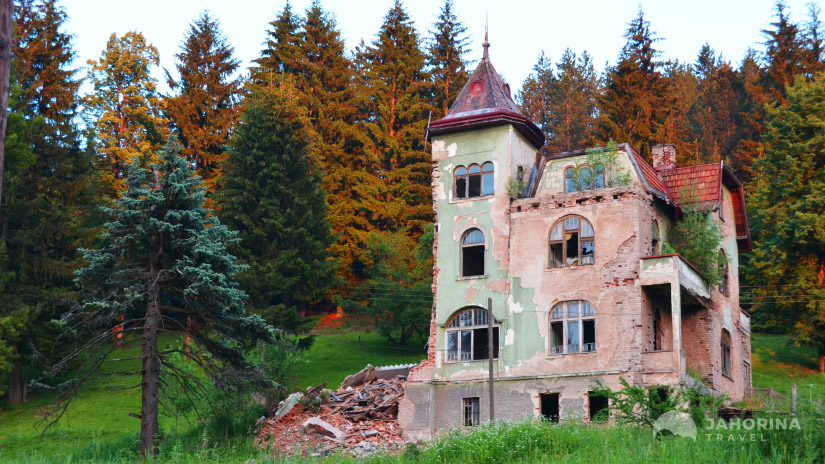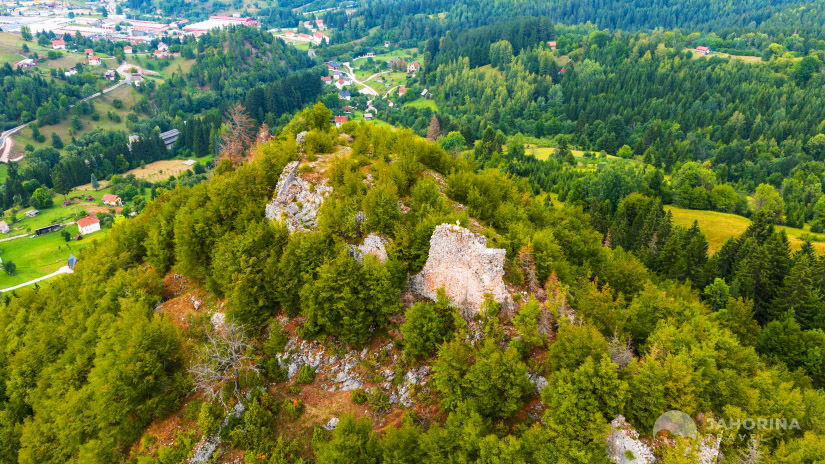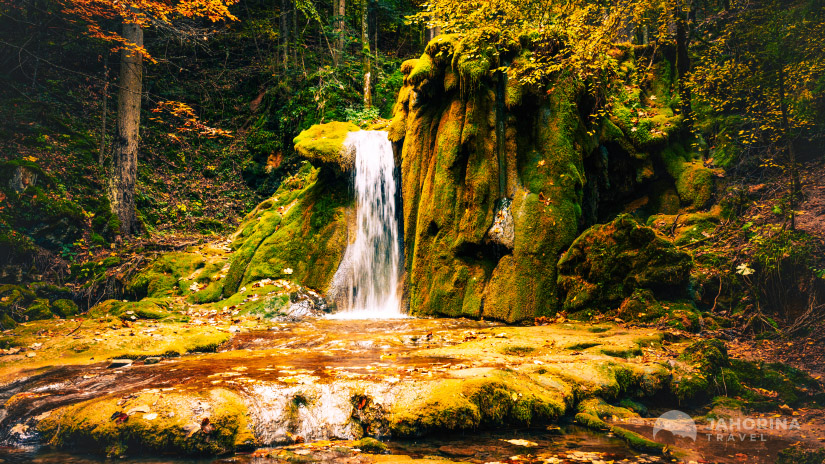Vrelo Miljacke is the main source of the Paljanska Miljacka River (there is also the Mokranjska Miljacka River), located in the settlement of Gornje Pale, beneath the ruins of the medieval Pavlović Fortress on the northern slopes of Ravna Planina (in the Jahorina mountain massif). The spring lies at an elevation of about 1,010 meters, roughly 2 km southeast of the center of Pale.
This spring represents a group of strong karst springs of gravitational type – the water comes mainly from surface precipitation (rain and snow) that infiltrates through cracks in the limestone base of Ravna Planina and accumulates underground within its massifs.
Thanks to this natural “reservoir” zone, the Paljanska Miljacka River emerges from several springs that merge into a single watercourse at the source itself. The water then descends as a small mountain stream through a forested slope, forming a series of small cascades and waterfalls over travertine blocks covered in moss. After about 250 meters of dynamic flow down the hillside, the stream enters the quieter Pale valley, where its riverbed widens. It still retains the characteristics of a fast mountain river, full of rocks and drops, even downstream from the spring.
The water temperature at the spring remains almost constant throughout the year (around 6–7 °C), which makes the water exceptionally clean and rich in oxygen. It is also drinkable (locals often say this is the place “where Miljacka is drunk”).
Origin of the Water and the Course of the Miljacka River
The spring water comes mainly from precipitation in the mountain areas of Ravna Planina and Jahorina. Jahorina’s winter snow cover and abundant autumn and spring rainfall saturate the limestone terrain, where the water collects underground and reappears in several places as powerful springs. During snowmelt or heavy rain, the springs become fuller and create louder waterfalls, while in dry summer months the flow decreases but does not dry up, thanks to the large underground water reserves. After emerging in Gornje Pale, the Paljanska Miljacka flows for about 12.9 km through the Pale area, receiving several small tributaries such as the Jahorina stream and Rapišnica. At the village of Dovlići, it enters a narrow, high canyon where it is joined on the right by the Mokranjska Miljacka, the second branch of the Miljacka River that emerges from a cave on the slopes of Romanija. The confluence of the Paljanska and Mokranjska Miljacka forms the Miljacka River in the proper sense, which then flows through Sarajevo and, after approximately 35–38 km, empties into the Bosna River near Ilidža.
It is less known that the Miljacka has two sources. In addition to the Paljanska Miljacka, there is the Mokranjska Miljacka, about 20.5 km long, which emerges from a cave near Kadin Selo at 1,135 meters above sea level. This impressive karst cave was explored in 2009 to a length of more than seven kilometers. The two rivers meet at Dovlići, which is why people often say that the Miljacka is the confluence of the “Jahorina and Romanija rivers.”

Natural Beauty and a Popular Excursion Spot
The surroundings of Vrelo Miljacke are exceptionally picturesque and rich in greenery throughout the year. The source stream flows through a dense coniferous forest, creating an enchanting atmosphere with the constant sound of water cascading over travertine steps and small waterfalls. In spring, when the springs swell, and in autumn, with heavy rainfall, the fast cascades over moss-covered rocks leave visitors breathless. The spring has long been a favorite excursion site for locals – since the Austro-Hungarian era, residents of Pale and Sarajevo have been coming here to enjoy the fresh mountain air and natural tranquility. A major advantage is its proximity to the town center: several hiking paths lead to the spring, and it can be reached on foot from Pale in about half an hour. The entire area is arranged as a picnic zone with space for walking, barbecuing, and recreation. During summer, the pleasant shade of the forest and the coolness of the stream make the air comfortably fresh even on hot days. Still, the clean mountain air and the silence broken only by the sound of water create an ideal atmosphere of peace and relaxation.
Old Sawmills and Villas

The area around the Miljacka spring, rich in water, forest, and stone, has long been suitable for early economic activity. In the 19th century, during the Austro-Hungarian administration, Pale became a center of the timber industry. In 1906, a narrow-gauge railway between Sarajevo–Pale–Užice was built through the Miljacka canyon, enabling large-scale timber export. Even earlier, small water-powered sawmills operated in Pale, and in 1898 the Sarajevo-based Hadžišabanović trading family built a more modern sawmill with two frame saws near Vrelo Miljacke. The sawmill initially served local needs, but with the arrival of the railway, its capacity and market expanded significantly.
The Hadžišabanović brothers also built their family villa in 1912 near the spring, a summer residence surrounded by nature, located just above the fishponds. This villa, also known as Vila Koran, is now declared a national monument. Unfortunately, the villa is neglected and partially collapsed – the remains of this once beautiful two-storey building still stand on a hill above the spring, representing the Austro-Hungarian architectural legacy in Pale.
In the surrounding area, the ruins of several old buildings, huts, and mills can still be seen, as well as stone bases where watermills and sawmills once stood. All of this reflects the rich past of the location, where natural resources were used responsibly and sustainably.
Fishponds and Restaurants

The water of the Paljanska Miljacka is exceptionally suitable for trout farming – it is always clean, cold, and rich in oxygen due to its rapids and waterfalls. Therefore, several decades ago, fishponds for trout farming were established just downstream from the spring. Today, two fishponds with restaurants operate at this site, well-known for serving fresh grilled trout and other traditional fish dishes. A special attraction is that the Miljacka stream flows directly through the restaurant gardens, allowing guests to dine next to the sound of spring water. Surrounded by greenery and fresh mountain air, visitors enjoy a unique nature-based dining experience.
Gradina Pavlovića – Medieval Fortress
Directly above the Miljacka spring, on a steep cone-shaped rock at 1,048 meters above sea level, lie the ruins of the Pavlović Fortress (Gradina Pavlovića). These are the remnants of a medieval fortress from the era of Bosnian nobility. The fortress dates back to prehistory; it was used by the Illyrians and later by the Romans, and was likely restored before the 14th century by a local lord as the administrative center of the Pavlović family for the Pale valley region. The Pavlović family, whose ancestor was Duke Pavle Radenović, was among the most powerful noble families in medieval Bosnia, with estates extending from the area of present-day Sarajevo to Dobrun.
The Pavlović family built at least three fortresses in the region: Pavlovac near Prača, the fortress in Pale, and Hodidjed at the confluence of the two Miljacka rivers. The fortress in Pale likely had no other name, and folklore later attributed its construction to “the accursed Jerina,” as with many Balkan fortresses. Its strategic role was to control the caravan trade route between Vrhbosna and Pavlovac and to protect the local population.

The fortress consisted of a lower and upper town. The lower part included enclosed outer courtyards that served as gardens and the first line of defense. The upper part had two stone towers and residential rooms. The highest round tower stood at the top of the rock, while a massive rectangular tower protected the entrance. The walls were built of limestone bonded with lime mortar. Inside the fortress, there was a cistern for storing water. Archaeological findings of ancient bricks and prehistoric pottery indicate that this location was used even earlier.
Today, the ruins of the fortress are in poor condition. The foundations of the towers and sections of walls several meters high can still be seen. Nearby is also a necropolis with medieval tombstones (stećci), where, according to tradition, some members of the Pavlović family were buried. Visiting the ruins and nearby forest paths adds to the overall experience of Vrelo Miljacke, combining natural beauty and rich cultural heritage in one place.




0 Comment